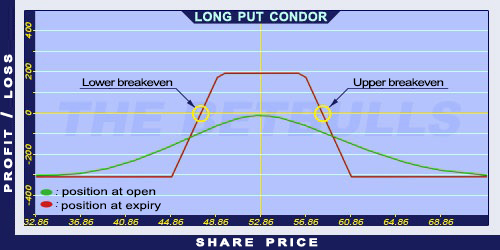Description and use
Long Put Condor option is the opposite of Short Put Condor. This strategy is popular, even though it is a net debit investment. The popularity is from the attractive risk/profit ratio. The longed options at the two sides guarantee limited risk. To establish the position, the trader must buy a lower strike OTM Long Put, in the middle there must be a lower strike OTM Short Put and a higher strike ITM Short Put, and finally, the trader must buy a higher strike ITM Long Put option. The investor can profit from share prices moving within given limits. The risk/profit ratio and the profit range is wider than for Long Butterfly Strategy. The direction of the market is neutral. The investor speculates on shares with low volatility and small price changes. The expected profit is relatively high, given the low costs. The expiration should be at least three months.
- Type: Neutral
- Transaction type: Debit
- Maximum profit: Limited
- Maximum loss: Limited
- Strategy: Neutral strategy
Opening the position
- Buy a lower strike (OTM) Put option.
- Sell a middle lower strike (OTM) Put option.
- Sell a middle higher strike (ITM) Put option.
- Buy a higher strike (ITM) Put option.
- All components must have the same expiration and only Put options are used. The difference between consecutive strike prices must be equal.
Steps
Entry:
- Make sure the share prices are moving within certain limits.
Exit:
- The position can be closed only before expiration.
Basic characteristics
Maximum loss: Net debit.
Maximum profit: Difference of two consecutive strike prices - Net debit.
Time decay: Time decay has a positive effect on the value when the position is profitable, and a negative effect when the position is lossmaking.
Lower breakeven point: Lower strike price + Net debit.
Upper breakeven point: Higher strike price - Net debit.
Advantages and disadvantages
Advantages:
- It is profitable when the prices are moving within certain limits and the costs are low.
- Low and limited risk.
- Relatively high risk/profit ratio.
Disadvantages:
- Potentially higher profit is only possible close to expiration.
- Limited profit.
Closing the position
Closing the position:
- Buy back the Short Puts and sell the Long Puts.
Mitigation of losses:
- Close the position the above-mentioned way.
Example
ABCD is traded for $52.87 on 17.05.2017. The investor buys a Long Put option which has a strike price of $45.00, expires in June 2017. and costs $0.51 (premium). Then he sells a Short Put option which has a strike price of $50.00, expires in June 2017. and costs $1.80 (premium). Then sells another Short Put option which has a strike price of $55.00, expires in June 2017. and costs $4.30 (premium). Finally, buys another Long Put option which has a strike price of $60.00, expires in June 2017. and costs $7.92 (premium).
Price of the underlying (share price): S= $52.87
Premium (Long Put 1): LP1= $0.51
Premium (Short Put 1): SP1= $1.80
Premium (Short Put 2): SP2= $4.30
Premium (Long Put 2): LP2= $7.92
Strike price (Long Put 1): KL1= $45.00
Strike price (Short Put 1): KS1= $50.00
Strike price (Short Put 2): KS2= $55.00
Strike price (Long Put 2): KL2= $60.00
Net debit: ND
Maximum loss: R
Maximum profit: Pr
Lower breakeven point: LBEP
Upper breakeven point: UBEP
Net debit: ND = (LP1 + LP2) - (SP1 + SP2)
Maximum loss (risk): R = ND
Maximum profit: Pr = (KL2 - KS2) - ND or Pr = (KL2 - KS1) – ND or Pr = (KL1 - KS1) - ND
Lower breakeven point: LBEP = KL1 + ND
Upper breakeven point: UBEP = KL2 - ND
ND = $2.33
R = $2.33
Pr = $2.67
LBEP = $47.33
UBEP = $57.67














